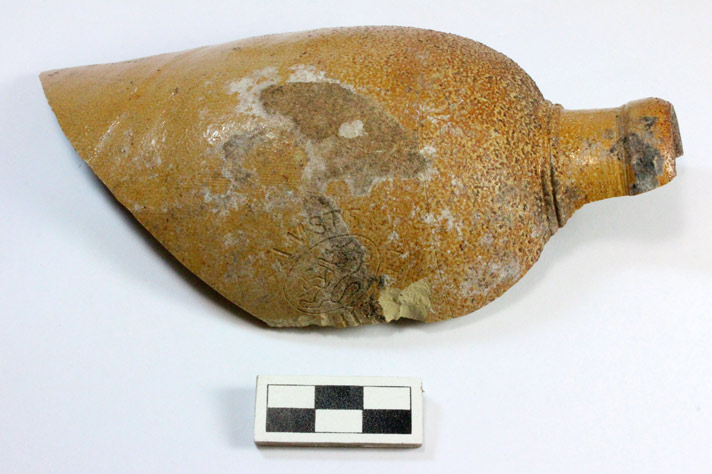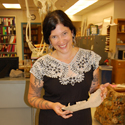Digging Jacksonville – July 2015
Summer is here, and for many of us that means the season for gin and tonics and frosty mugs of beer! A recent archaeological find along First Street reminded us that Jacksonville’s 19th century residents shared our love of the cocktail hour, and highlighted the lengths that early residents went to procure their favorite alcoholic beverages. During construction for the new sidewalk connecting downtown to the Britt Festival grounds, dozens of liquor bottles were found buried beneath the roadway. The majority of these bottles were hand-blown glass liquor bottles, but there were also a handful of stoneware ale bottles, and most interesting—stoneware gin bottles. The gin bottles were manufactured by Wynand Fockink of Amsterdam, and travelled a very long way to Oregon’s rugged frontier. The Wynand Fockink distillery opened in 1679, and is still in business today.
The gin bottles, along with the other liquor bottles imported from both distant domestic and foreign markets, were likely brought to Jacksonville for resale by the Fisher Brothers, who lived on the corner of First and Main Streets at this time. The Fisher Brothers were some of the earliest merchants in Jacksonville, and advertisements placed in the 1856 Table Rock Sentinel describe them as dealers of “staple and fancy goods, ready-made clothing, boots, shoes, hats, caps, stationery, cutlery” among other household wares. While they offered a wide range of domestic items, Abraham Fisher is also listed on the 1867 tax rolls as a “liquor wholesaler.” This could suggest that the Fisher Brothers also supplied saloons with whiskey, ale, and gin from as far away as the Netherlands.
The collection of bottles found under First Street date to between the late 1850s and early 1860s. This era represents the earliest incarnation of the town along Main Street, before the bulk of the businesses shifted over to California Street and the neighborhood became the Chinese Quarter. Keeping in-mind this early date, the presence of these bottles is interesting in light of the known limitations of the commercial enterprises in the mid-19th century. Jacksonville was settled in proximity to the gold strikes, not accessible commercial or transportation routes, and therefore it was not easily reached by large market hubs. However, despite the difficulty in acquiring goods, the desire for imported liquor (which came in heavy and breakable bottles) was great enough that these items were shipped from distant ports over rough mountain terrain on pack mules. Ironically, although the first Fisher Brothers warehouse was located next to the Viet Schutz brewery, and just a few blocks away from the Eagle Brewery, readily available fresh beer clearly could not fully quench the desire for hard liquor. Thus, fragments of the handmade stoneware bottles that travelled all the way from Amsterdam—over sea, and across hundreds of miles on the back of a mule—found themselves buried beneath the streets of Jacksonville. While the analysis of these artifacts is ongoing, it is a fun reminder that we are not so different from our historical counterparts, whose discerning tastes relished a stiff drink from a distant distillery in addition to the readily available local beer after a long day’s work on a hot summer day.
This project was funded by the City of Jacksonville and the Oregon Department of Transportation.

 Chelsea Rose is an historical archaeologist who specializes in the settlement and development of the American West. Chelsea and the Southern Oregon University Laboratory of Anthropology (SOULA) conduct archaeology across Oregon and have done several projects in Jacksonville. You can reach Chelsea at rosec@sou.edu and follow SOULA on
Chelsea Rose is an historical archaeologist who specializes in the settlement and development of the American West. Chelsea and the Southern Oregon University Laboratory of Anthropology (SOULA) conduct archaeology across Oregon and have done several projects in Jacksonville. You can reach Chelsea at rosec@sou.edu and follow SOULA on